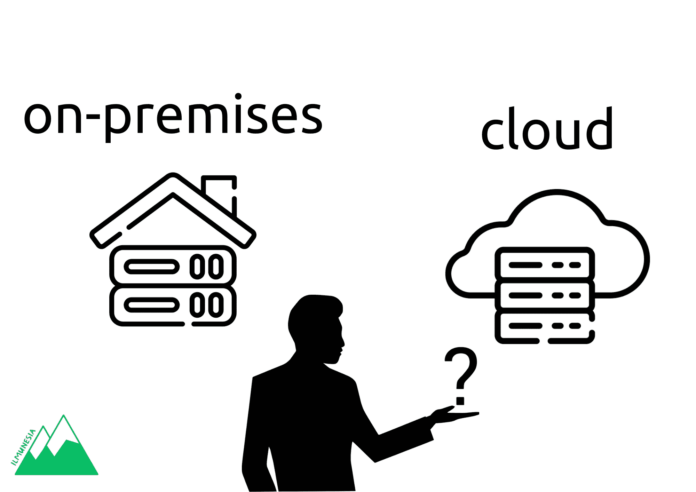In today’s digital age, businesses face a critical decision regarding where to host their IT infrastructure. They can either house resources “on-premises” within the organization’s physical data center or utilize cloud service provider’s data center infrastructure through a subscription model. The choice between these two options hinges on various factors like cost, security, scalability, and organizational preferences. This article explores the differences between on-premises and cloud hosting, and how to determine which solution is best for your needs.

Table of Contents
What Is Cloud Hosting?
Cloud hosting involves placing compute resources—such as storage, applications, processing, and virtualization—in third-party data centers accessed through the public internet. This model provides numerous benefits, including scalability, flexibility, and cost efficiency.
Key Benefits of Cloud Hosting
- Scalability: Cloud hosting allows businesses to scale resources up and down quickly, paying only for what they use. This flexibility is ideal for managing variable workloads and accommodating business growth without significant upfront investment.
- Agility: Cloud services can be deployed rapidly, enabling businesses to respond swiftly to market changes and opportunities. This agility supports innovation and accelerates time-to-market for new applications and services.
- Cost Efficiency: Cloud hosting offers a low cost of entry and the ability to scale resources without incurring the cost of acquiring physical data center resources.
What Is On-Premises Hosting?
On-premises hosting involves placing compute resources in a data center environment that an organization builds and maintains. Connectivity might be through a private network locally, as well as through the public internet for dispersed users.
Key Benefits of On-Premises Hosting
- Control: On-premises hosting provides more direct control over the infrastructure, allowing for customized configurations and specific security measures tailored to the organization’s needs.
- Security: An on-premises deployment can be theoretically more secure since it is isolated from the public internet and shared resources.
- Compliance: On-premises hosting may be necessary for organizations with strict data governance and data integrity rules, ensuring compliance with legal and regulatory requirements.
Must read: Top 10 GitLab CI Best Practices
Hybrid and Private Cloud Solutions
Hybrid Cloud
A hybrid cloud is a combination of cloud and on-premises deployments unified in a centralized platform for management and orchestration. This approach offers the benefits of both worlds, allowing organizations to optimize their infrastructure according to their specific needs.
Private Cloud
A private cloud is a cloud environment hosted and accessed within an office, campus, or other location. Private clouds provide cloud experiences similar to public clouds, such as universal connectivity, streamed applications, centralized data, and workspaces. Some vendors offer virtual private clouds using dedicated, logically isolated sections and technology that allows customers to assign their own IP addresses to resources.
Factors to Consider When Choosing Between On-Premises and Cloud Hosting
Agility
Cloud hosting has the advantage of quickly scaling resources while only paying for what you use. However, for some organizations, an on-premises deployment might provide more agility, enabling specific development or orchestration techniques.
Resilience
Established cloud providers have standards for reliability and uptime, with processes in place to respond and recover from incidents. However, if a security incident affects all the provider’s customers, or if the incident blocks access to data for a period of time, resilience is less effective.
Cost Management
The cloud offers a low cost of entry and the ability to scale resources dramatically without incurring the cost of acquiring data center resources. While cloud costs may be lower, they can fluctuate, causing budgeting and cost management headaches. On-premises hosting costs may be higher but are more predictable, which can be preferable for organizations seeking stable IT infrastructure costs.
Evolving Technologies
Major cloud providers can incorporate the latest advancements and offer them to customers. If IT is on-premises, the need to incorporate new technologies will fall on the company’s IT department and its budget.
Purpose-built Hardware
Organizations using specialized hardware deployed on-premises may find it challenging to replicate that hardware in a cloud data center.
IT Management
Cloud providers aim to make IT easier, offering customer-centric tools and interfaces with features for easy management. However, on-premises deployment may provide more direct control, available 24/7.
Staffing
The challenges of IT staffing go beyond simply costs. If an on-premises deployment requires specialized staff, retaining that staff becomes critical. Using a cloud provider can help by removing the risk and headaches of staffing.
Compliance
Rules for data governance and data integrity, especially regarding where data is stored, may dictate that some organizations avoid the cloud.
Computing Performance
A local private network connected to a locally hosted data center can operate at a higher level of performance than a cloud deployment relying on shared resources within the data center and the shared bandwidth and connectivity of the public internet.
Security
Both cloud and on-premises hosting have security advantages. An on-premises deployment is theoretically less vulnerable since it is isolated from the public internet. However, cloud providers can maintain high security standards that might be tough to replicate with an on-premises deployment.
Conclusion
The decision between cloud and on-premises hosting is not a simple either/or choice. To serve specific, complex needs, many organizations end up using a combination of clouds, both private and public. Their public cloud instances may be spread across numerous cloud providers. The endless possibilities allow every organization to adopt the hybrid/multi-cloud environment that fits its needs.

